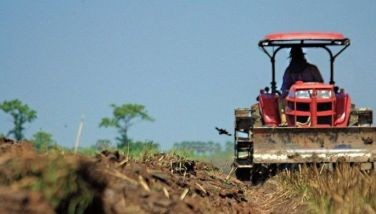Good prospects for goat raising
December 21, 2003 | 12:00am
The Department of Agriculture is pushing for the development of the domestic goat industry. Prospects are high as demand is higher than supply and goat raising requires relatively simple technology.
At present, the country has a goat population of 3,311,724 broken down as follow: CAR: Cordillera Autonomous Region (54,127); Region I (456,791); II (140,671); III (234,081); IV (254,849); V (93,189); VI (353,879); VII (486,028); VIII (72,335); IX (123,789); X (186,752); XI (321,632); XII (239,518); CARAGA (106,271); and ARMM: Autonomous Regions of Muslim Mindanao (187,816).
The industry has a population base from which to build on. Private sector is strong in Bacolod, Nueva Ecija, Pampanga, Pangasinan and Tarlac. LGUs (local government units) in Ilocos, Quezon, Lanao and ARMM as well as RFUs (regional field units) in Regions II and VI and Palawan are bullish on goat raising.
The road map being pushed by DA calls for the following program thrusts and targets:
• Reducing the mortality rate from 45-60 percent to 25 percent; • Increasing the current reproduction efficiency from 1.72 per cent to 10 per cent; and
• Increasing the slaughter weight from 15 kilos to 20 kilos.
Four strategies are in the pipeline for the improvement of the country’s goat production:
Strategy I: Partnerships by and among national government agencies, RFUs, LGUs, private sector, livestock groups/ associations, NGOs (non-government organizations) and POs (people’s organizations) and academe. The cooperation is geared towards policy formulation, programs/projects, research and development and creation of the small ruminant board.
Strategy II: Genetic improvement in the form of seed stock production, upgrading of breeder stocks, accreditation of breeder farms and stocks. This strategy is programmed towards top quality breeders for commercial and backyard goat farming.
Strategy III: Promotion of low-cost disease control measures — focus on deworming — through technology and information dissemination. This will be in the form of technical assistance, field schools, information materials, training and seminars among RFUs, LGUs and farmer organizations.
Strategy IV: Continuing development/dissemination of technology packages (extension service) through Centers of Technology Development/Dissemination in Luzon (Central Luzon State University); in the Visayas (DA-RFU-VIII); in Mindanao (Mindanao Baptist Rural Life Center).
The strategies are meant to counter the following constrainst: 1) High mortality due to diseases and parasites; 2) Insufficient breeder base in terms of quantity and quality; 3) Inadequate support services in extension, credit, research and development;
4) Absence of a focused development plan for the industry.
Building on current population and initiatives, the development approach will be through clustering production areas. 1) Ilocos and Cagayan Valley; 2) Central Luzon and Southern Tagalog; 3) Eastern Visayas, Western Visayas and Central Visayas; 4) North Mindanao, South Mindanao and ARMM.
Target production is 36,906 metric tons next year from 33,550 metric tons this year.
At present, the country has a goat population of 3,311,724 broken down as follow: CAR: Cordillera Autonomous Region (54,127); Region I (456,791); II (140,671); III (234,081); IV (254,849); V (93,189); VI (353,879); VII (486,028); VIII (72,335); IX (123,789); X (186,752); XI (321,632); XII (239,518); CARAGA (106,271); and ARMM: Autonomous Regions of Muslim Mindanao (187,816).
The industry has a population base from which to build on. Private sector is strong in Bacolod, Nueva Ecija, Pampanga, Pangasinan and Tarlac. LGUs (local government units) in Ilocos, Quezon, Lanao and ARMM as well as RFUs (regional field units) in Regions II and VI and Palawan are bullish on goat raising.
The road map being pushed by DA calls for the following program thrusts and targets:
• Reducing the mortality rate from 45-60 percent to 25 percent; • Increasing the current reproduction efficiency from 1.72 per cent to 10 per cent; and
• Increasing the slaughter weight from 15 kilos to 20 kilos.
Four strategies are in the pipeline for the improvement of the country’s goat production:
Strategy I: Partnerships by and among national government agencies, RFUs, LGUs, private sector, livestock groups/ associations, NGOs (non-government organizations) and POs (people’s organizations) and academe. The cooperation is geared towards policy formulation, programs/projects, research and development and creation of the small ruminant board.
Strategy II: Genetic improvement in the form of seed stock production, upgrading of breeder stocks, accreditation of breeder farms and stocks. This strategy is programmed towards top quality breeders for commercial and backyard goat farming.
Strategy III: Promotion of low-cost disease control measures — focus on deworming — through technology and information dissemination. This will be in the form of technical assistance, field schools, information materials, training and seminars among RFUs, LGUs and farmer organizations.
Strategy IV: Continuing development/dissemination of technology packages (extension service) through Centers of Technology Development/Dissemination in Luzon (Central Luzon State University); in the Visayas (DA-RFU-VIII); in Mindanao (Mindanao Baptist Rural Life Center).
The strategies are meant to counter the following constrainst: 1) High mortality due to diseases and parasites; 2) Insufficient breeder base in terms of quantity and quality; 3) Inadequate support services in extension, credit, research and development;
4) Absence of a focused development plan for the industry.
Building on current population and initiatives, the development approach will be through clustering production areas. 1) Ilocos and Cagayan Valley; 2) Central Luzon and Southern Tagalog; 3) Eastern Visayas, Western Visayas and Central Visayas; 4) North Mindanao, South Mindanao and ARMM.
Target production is 36,906 metric tons next year from 33,550 metric tons this year.
BrandSpace Articles
<
>
- Latest
Latest
Latest
March 4, 2024 - 3:32pm
By Ian Laqui | March 4, 2024 - 3:32pm
March 4, 2024 - 2:12pm
By Kristine Daguno-Bersamina | March 4, 2024 - 2:12pm
February 17, 2024 - 2:31pm
February 17, 2024 - 2:31pm
February 13, 2024 - 7:24pm
By Gaea Katreena Cabico | February 13, 2024 - 7:24pm
February 13, 2024 - 7:17pm
By Ian Laqui | February 13, 2024 - 7:17pm
Recommended




























